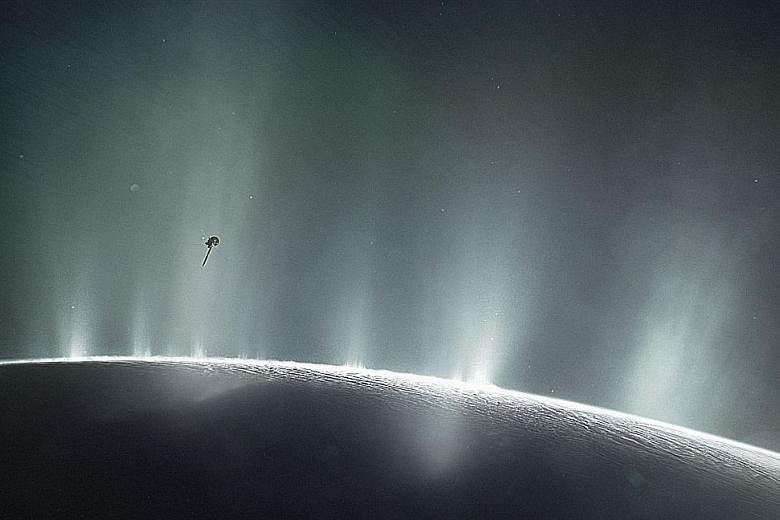WASHINGTON • An ice-encrusted moon orbiting Saturn appears to have the conditions necessary for life, Nasa announced, unveiling new findings made by its unmanned Cassini spacecraft.
Cassini has detected hydrogen molecules in vapour plumes emanating from cracks in the surface of Enceladus, a small ocean moon coated in a thick layer of ice, the US space agency said.
The plumes have led scientists to infer that hydrothermal chemical reactions between the moon's rocky core and its ocean - located under the ice crust - are likely occurring on Enceladus.
On Earth, those chemical reactions allow microbes to flourish in hot cracks in the planet's ocean floors - depths sunlight cannot reach - meaning the moon could also nourish life.
"Now, Enceladus is high on the list in the solar system for showing habitable conditions," said Dr Hunter Waite, one of the study's leading researchers. The new research, published on Thursday in the journal Science, "indicates there is chemical potential to support microbial systems", he said.
The hydrogen detection resulted from Cassini's October 2015 deep dive close to Enceladus' surface. Using a spectrometer, the spacecraft determined that the plumes are 98 per cent water and 1 per cent hydrogen, with traces of molecules including ammonia, carbon dioxide and methane.
Hydrogen had previously been "elusive", scientists said, but its detection shows the moon's life-supporting potential. The hydrogen in the sub-surface ocean could combine with carbon dioxide molecules in a process known as "methanogenesis", which creates a byproduct of methane. If there are indeed microbes living in the moon's ocean, they could tap that energy source as sustenance.
Scientists said the moon looked to have ample energy supplies to support life - about the equivalent of 300 pizzas per hour, according to geochemist Christopher Glein at the Southwest Research Institute in Texas. "This is the first time we've been able to make a calorie count of an alien ocean," he said.
Though Cassini does not have instruments capable of actually finding signs of life, "we've found that there's a food source there for it", said Dr Waite. "It would be like a candy store for microbes."
Dr Jeffrey Seewald of the Woods Hole Oceanographic Institution echoed those comments in a companion article to the study: "This observation has fundamental implications for the possibility of life on Enceladus." He added: "Chemical disequilibrium that is known to support microbial life in Earth's deep oceans is also available to support life in the Enceladus ocean."
AGENCE FRANCE-PRESSE

